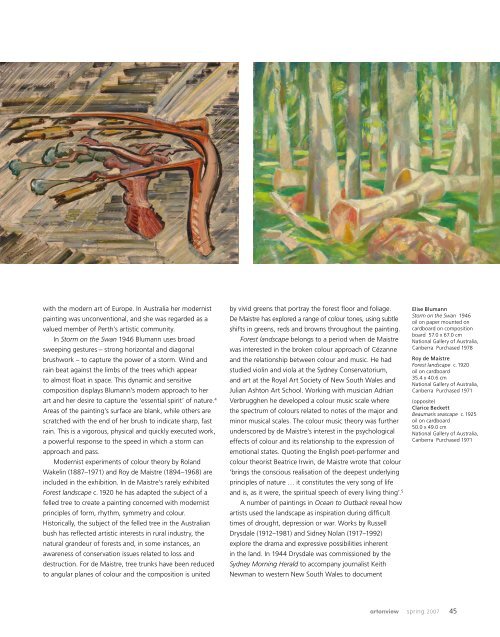Art Ew - National Gallery of Australia
Art Ew - National Gallery of Australia
Art Ew - National Gallery of Australia
Create successful ePaper yourself
Turn your PDF publications into a flip-book with our unique Google optimized e-Paper software.
with the modern art <strong>of</strong> Europe. In <strong>Australia</strong> her modernist<br />
painting was unconventional, and she was regarded as a<br />
valued member <strong>of</strong> Perth’s artistic community.<br />
In Storm on the Swan 1946 Blumann uses broad<br />
sweeping gestures – strong horizontal and diagonal<br />
brushwork – to capture the power <strong>of</strong> a storm. Wind and<br />
rain beat against the limbs <strong>of</strong> the trees which appear<br />
to almost float in space. This dynamic and sensitive<br />
composition displays Blumann’s modern approach to her<br />
art and her desire to capture the ‘essential spirit’ <strong>of</strong> nature. 4<br />
Areas <strong>of</strong> the painting’s surface are blank, while others are<br />
scratched with the end <strong>of</strong> her brush to indicate sharp, fast<br />
rain. This is a vigorous, physical and quickly executed work,<br />
a powerful response to the speed in which a storm can<br />
approach and pass.<br />
Modernist experiments <strong>of</strong> colour theory by Roland<br />
Wakelin (1887–1971) and Roy de Maistre (1894–1968) are<br />
included in the exhibition. In de Maistre’s rarely exhibited<br />
Forest landscape c. 1920 he has adapted the subject <strong>of</strong> a<br />
felled tree to create a painting concerned with modernist<br />
principles <strong>of</strong> form, rhythm, symmetry and colour.<br />
Historically, the subject <strong>of</strong> the felled tree in the <strong>Australia</strong>n<br />
bush has reflected artistic interests in rural industry, the<br />
natural grandeur <strong>of</strong> forests and, in some instances, an<br />
awareness <strong>of</strong> conservation issues related to loss and<br />
destruction. For de Maistre, tree trunks have been reduced<br />
to angular planes <strong>of</strong> colour and the composition is united<br />
by vivid greens that portray the forest floor and foliage.<br />
De Maistre has explored a range <strong>of</strong> colour tones, using subtle<br />
shifts in greens, reds and browns throughout the painting.<br />
Forest landscape belongs to a period when de Maistre<br />
was interested in the broken colour approach <strong>of</strong> Cézanne<br />
and the relationship between colour and music. He had<br />
studied violin and viola at the Sydney Conservatorium,<br />
and art at the Royal <strong>Art</strong> Society <strong>of</strong> New South Wales and<br />
Julian Ashton <strong>Art</strong> School. Working with musician Adrian<br />
Verbrugghen he developed a colour music scale where<br />
the spectrum <strong>of</strong> colours related to notes <strong>of</strong> the major and<br />
minor musical scales. The colour music theory was further<br />
underscored by de Maistre’s interest in the psychological<br />
effects <strong>of</strong> colour and its relationship to the expression <strong>of</strong><br />
emotional states. Quoting the English poet-performer and<br />
colour theorist Beatrice Irwin, de Maistre wrote that colour<br />
‘brings the conscious realisation <strong>of</strong> the deepest underlying<br />
principles <strong>of</strong> nature … it constitutes the very song <strong>of</strong> life<br />
and is, as it were, the spiritual speech <strong>of</strong> every living thing’. 5<br />
A number <strong>of</strong> paintings in Ocean to Outback reveal how<br />
artists used the landscape as inspiration during difficult<br />
times <strong>of</strong> drought, depression or war. Works by Russell<br />
Drysdale (1912–1981) and Sidney Nolan (1917–1992)<br />
explore the drama and expressive possibilities inherent<br />
in the land. In 1944 Drysdale was commissioned by the<br />
Sydney Morning Herald to accompany journalist Keith<br />
Newman to western New South Wales to document<br />
Elise Blumann<br />
Storm on the Swan 1946<br />
oil on paper mounted on<br />
cardboard on composition<br />
board 57.0 x 67.0 cm<br />
<strong>National</strong> <strong>Gallery</strong> <strong>of</strong> <strong>Australia</strong>,<br />
Canberra Purchased 1978<br />
Roy de Maistre<br />
Forest landscape c.1920<br />
oil on cardboard<br />
35.4 x 40.6 cm<br />
<strong>National</strong> <strong>Gallery</strong> <strong>of</strong> <strong>Australia</strong>,<br />
Canberra Purchased 1971<br />
(opposite)<br />
Clarice Beckett<br />
Beaumaris seascape c.1925<br />
oil on cardboard<br />
50.0 x 49.0 cm<br />
<strong>National</strong> <strong>Gallery</strong> <strong>of</strong> <strong>Australia</strong>,<br />
Canberra Purchased 1971<br />
artonview spring 2007 45

















